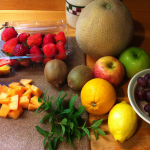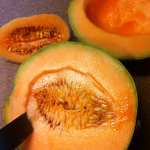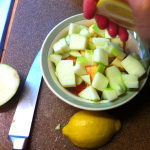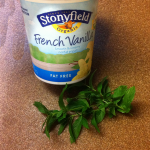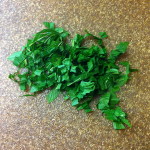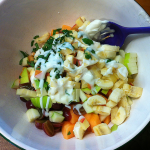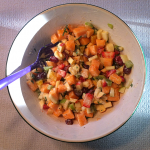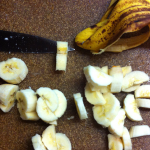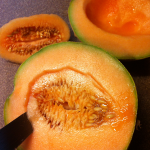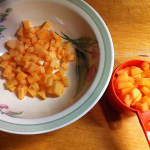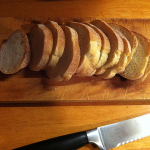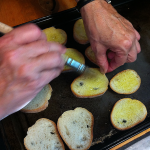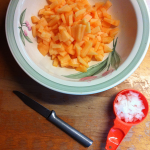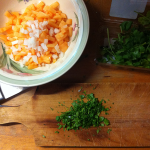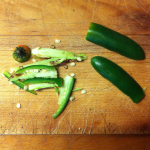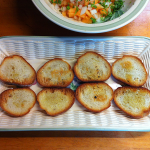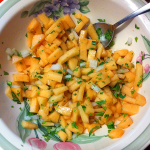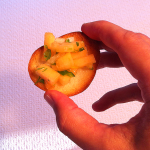This Meatless Monday, we feature melon, with growing, storage and prep tips, as well as recipes for Cantaloupe Salsa with Crostini and Fruit Salad from Vermont Fresh: A Fruit and Vegetable Handbook.
Background
Melons usually fall into two distinct categories: the ever-popular watermelons, and the Cucumis melons (commonly called “musk melons”), which include everything else. Cantaloupe and honeydew melons, for example, are pretty closely related, but watermelons are a more distant relative. The Cucumis melons probably originated in the region around present-day Afghanistan, whereas watermelons are native to Africa. If you’ve ever seen melons growing before, you may not be surprised to learn that the vine-like plants belong to the same family as cucumbers. Melons have been grown since ancient times, but it is believed that they were not bred for today’s high levels of sweetness until a few centuries ago.
Growing Tips
Melons of all varieties need plenty of warmth and a long growing season. Start seeds indoors and transplant seedlings once the weather warms. Start seeds in early April in pots with some compost mixed into the potting soil. Seeds need warmth to germinate, so be sure to start them in one of the warmer rooms of your house! Plant melons in rich, well-drained soil that is enriched with compost. To give them a boost, grow your melons on black plastic, which will increase the temperature around them by a few degrees as well as keep down weeds. Space plants several feet apart, as they will spread. Rodents and cucumber beetles like to feed on tender young melon plants, so you may wish to protect them at first with floating row cover (removing it when plants bloom). Melons cannot tolerate frost, so be sure to both plant and harvest in the frost-free summer window.
Storage
Watermelons will not continue to ripen after they have been picked and should be immediately refrigerated and eaten as soon as possible, though you may store it this way for a few days. Most other melons can sit out at room temperature for a few days until they ripen, but once ripe they should also be refrigerated and eaten within a few days.
Nutritional Benefits
Melons are comprised mostly of water, so they are fairly low in calories despite their sweet taste. Though the nutritional value of melons varies among varieties, they tend to be high in Vitamin C and beta carotene.
Preparation
Melons are delicious with minimal preparation, but it can be difficult to tell when they are ripe. Watermelons should have a creamy, pronounced spot where they rested on the ground and have slightly waxy skin. Other melons may “slip” from the vine when ripe, will smell faintly sweet, and should be barely tender on the ends.
Shannon Palmer, a volunteer baking, tasting and testing recipes out of the Vermont Fresh Handbook tried out these two recipes. Her comments and adjustments are in italics.
Meatless Monday Recipe: Fruit Salad
- Photo courtesy of Shannon Palmer
- Photo courtesy of Shannon Palmer
- Photo courtesy of Shannon Palmer
- Photo courtesy of Shannon Palmer
- Photo courtesy of Shannon Palmer
- Photo courtesy of Shannon Palmer
- Photo courtesy of Shannon Palmer
- Photo courtesy of Shannon Palmer
- Photo courtesy of Shannon Palmer
prep time: 15 mins
serves 8
Ingredients
- 1-2 apples, cored and chopped
- splash of lemon juice
- 3 heaping cups of melon of any variety, chopped, seeds removed (I used cantaloupe)
- 1 orange, peeled and chopped
- 1 cup grapes, halved
- 1 pear, cored and chopped (I used strawberries instead)
- 2 kiwis, peeled and chopped
- 1 banana
- Other fruits as desired
- (optional) handful of fresh mint chopped & 1/2 cup of vanilla yogurt
Instructions
- Put chopped apples in a large salad bowl and toss with the lemon juice (this prevents unattractive browning of the apples).
- Add all other chopped fruits and toss. Chill in the refrigerator for up to several hours before serving.
- Peel, chop, and add banana just before serving to keep it from turning brown and mushy.
- For an extra twist, add fresh chopped mint and drizzle in some yogurt as a dressing (I like vanilla)
Meatless Monday Recipe: Cantaloupe Salsa with Crostini
- Photo courtesy of Shannon Palmer
- I would make my melon a finer dice than this in the future. Photo courtesy of Shannon Palmer
- Photo courtesy of Shannon Palmer
- Photo courtesy of Shannon Palmer
- Photo courtesy of Shannon Palmer
- Photo courtesy of Shannon Palmer
- Photo courtesy of Shannon Palmer
- Photo courtesy of Shannon Palmer
- Photo courtesy of Shannon Palmer
- Photo courtesy of Shannon Palmer
prep time: 20 mins
serves 6
Ingredients
- 2 cups cantaloupe, finely diced
- ¼ cup sweet onion, finely chopped
- 1 handful fresh basil leaves, finely chopped (I didn’t have basil so I used cilantro)
- 1 relatively hot chile, minced (or a small bell pepper for a mild version)
- 1 tablespoon lime juice
- ¼ teaspoon salt
- ½ baguette
- 2 tablespoons olive oil
Instructions
- Preheat oven to 350°F.
- Toss cantaloupe, onion, basil, chile, lime, and salt in a bowl. Let stand to allow flavors to mix.
- Meanwhile, slice baguette into ¼ inch-thick slices, brush each with olive oil, and place in a single layer on a cookie sheet. Sprinkle lightly with salt if desired.
- Toast baguette slices until golden, about 10 minutes. Allow to cool slightly, then serve with the salsa.
These were delicious! Who knew melon went so well with onions, jalepeno, and cilantro!
To receive more recipes and tips on your favorite fruits and vegetables, download Vermont Fresh: A Fruit and Vegetable Handbook. We also need more volunteer home chefs for this project.
Vermont Foodbank fresh food initiatives would not be possible without your support. Please consider giving to the Vermont Foodbank today!


